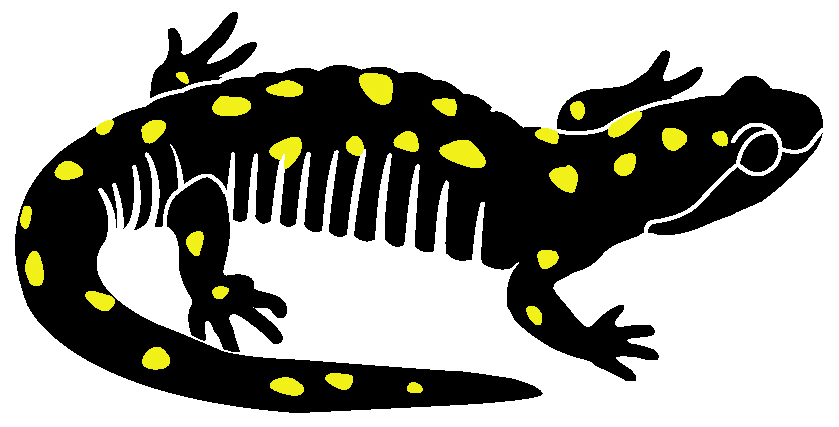Jefferson Salamander
Ambystoma jeffersonianum
Adults
The Jefferson salamander (5-7.5") is a chocolate brown to blue-black animal with light blue flecking on its lower sides, legs and tail. They are secretive, living underground in the forest up to one-half mile from their breeding pool. They might be found when looking under logs and other cover objects but, generally, finding a Jefferson salamander is a rare event except for breeding nights in early spring.
Migration to the breeding pools is the earliest for any of the mole salamanders, sometimes taking place on rainy nights with ground only partially thawed and ice still on the pools. At the pools, males and females locate each other by chemical cues and the male courts the female with snout rubbing, clasping, mutual swimming and tail waving. If the female is receptive, the male drops spermatophores and the female picks up sperm from them in her cloaca.
Eggs
A few days after mating, the female lays up to 250 eggs in small clusters of 12-75 eggs attached to vegetation near the water surface. The masses are clear, have a loose consistency and are difficult to see. They are tubular when attached to twigs and irregular when attached to soft vegetation. They may become greenish from algal growth. Embryos develop quickly and hatch within 4-6 weeks, usually before the eggs of the spotted salamander which might be using the same pool.
Larvae
Young larvae hide within the leaf litter and are fiercely predatory on all manner of invertebrates and even other salamanders. As they grow, they feed in the open water of the pool where they may be observed at night and on sunny days hunting near the water surface. They are preyed upon primarily by predatory insects. Larvae complete development in 2-4 months and leave the pool for small mammal burrows in the forest. Sexual maturity is reached in 3 years. Life span may be another three years in nature.
Jefferson/Blue-spotted Salamander Complex
Throughout Massachusetts are found hybrid salamanders which have physical characteristics intermediate between Jefferson and blue-spotted salamanders. These hybrid animals are the result of historic crosses between the two parent species as long ago as the end of the last glaciation. Neither the origin of these hybrids nor the methods of their reproduction is fully understood. Most all of the hybrids are female and have extra sets of chromosomes making them polyploid animals. However, some of the hybrids are diploid having one set each of Jefferson and blue-spotted chromosomes.
Experienced researchers can sometimes identify the diploid hybrids as Jefferson or blue-spotted by the relatively wide head of the Jefferson or by the wider blue spots of the blue-spotted as well as other equally subtle characteristics. The polyploid specimens can only be accurately identified by blood analysis or karyotyping. The hybrids are assigned as either Jefferson or blue-spotted based on the parent species from which they have more sets of chromosomes or, if the values are equal, to coincide with the prevalent local species.
For field identification, if the hybrid is found west of the Connecticut River, it should be considered a Jefferson salamander. If it is found east of the Connecticut River, it should be considered a blue-spotted salamander.
Jefferson Salamander is legally protected and listed as Special Concern pursuant to the Massachusetts Endangered Species Act (M.G.L. c. 131A) and implementing regulations (321 CMR 10.00).

Jefferson Salamander
For further information, consult the NHESP Fact Sheet for Jefferson Salamander.

The Jefferson salamander, Ambystoma jeffersoniamum, is a large, secretive mole salamander seldom seen expect on breeding nights in early spring.

Jefferson salamander eggs are deposited in small clusters attached to vegetation. The mass is flimsy, transparent, and cryptic.

Larvae are dark pigmented, have a broad head and a white throat like the spotted and blue-spotted larvae.

Jefferson larvae are carnivorous and feed upon most any invertebrates or small vertebrates it can capture. This larva is eating a chironomid midge larva.

Larvae absorb their gills as they metamorphose into a land-dwelling salamander. This larva has gill remnants just behind the head.

